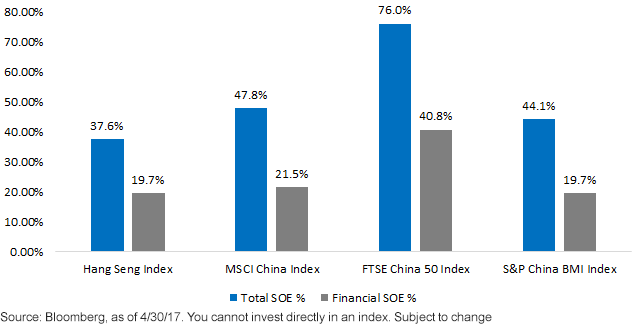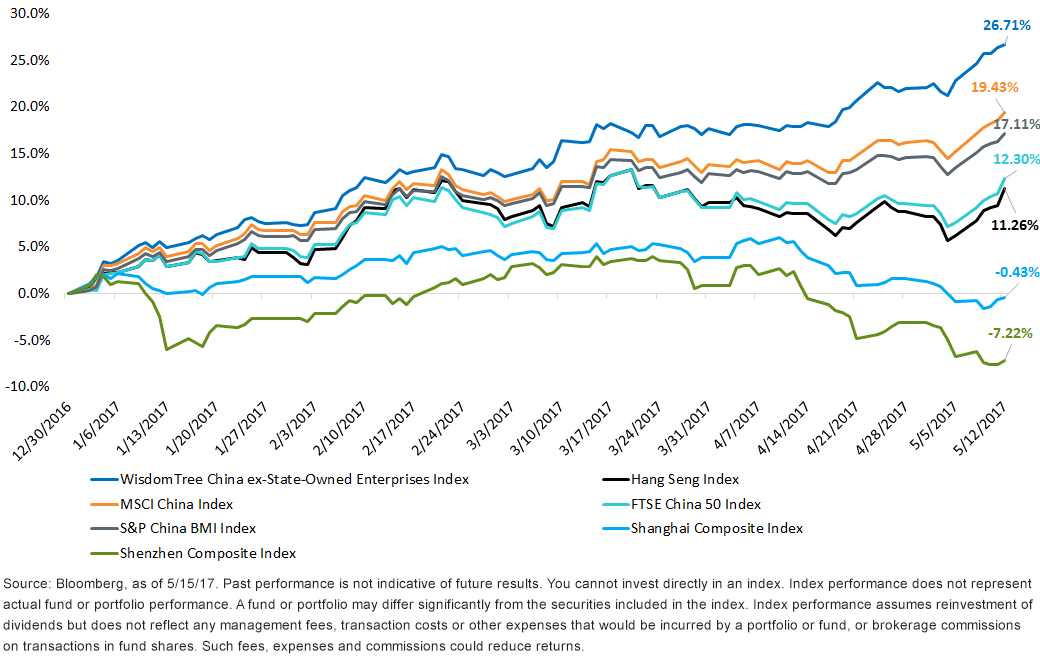China's Leverage Crackdown and What It Means for Stocks


For the last several decades, China’s economy has been growing at an extraordinary clip and now stands as the second largest economy in the world. Inevitably that rate must slow, which is exactly what has happened each year since 2010.
The absolute rate of growth of the economy is a strong point of pride in China, and authorities in the country have historically made it clear each year what they would like to see as the target growth rate. For the last several years, however, that growth mandate may have come at the expense of stability in the economy.
China is unique in that much of the private sector is concentrated in state-owned enterprises (SOE), which can be heavily influenced by government entities. Some critics have argued that these state-owned corporations have been encouraged to take on excessive leverage in order to help prop up the culturally significant gross domestic product (GDP) growth rate. This way, a hard landing would make way for a gradual slowdown. The hard landing has thus far been avoided, but at a cost, as China’s total debt/GDP ratio has soared in recent years, climbing from 194% of GDP in 2011 to 258% at the end of 2016.1
Changes Coming from the Top
The Chinese authorities had seemed to largely ignore the growing number of red flags as long as the economy chugged along as desired. However, the past few months have seen a marked change in behavior from the top down.
- In March, China’s premier, Li Keqiang, set the 2017 GDP growth target of “around 6.5%, or higher if possible,”2 providing flexibility in verbiage and implying that the minimum growth rate was not the traditional meet-or-else requirement.
- On April 25, President Xi Jinping gathered together some of the top politicians to discuss “safeguarding national financial-market security.”3 That the president led this meeting (as opposed to bankers and regulators) should underscore how serious the government is about fixing the debt issue.
- Importantly, accelerating the urgency of the situation is the upcoming twice-a-decade leadership transition, which will take place later this fall. Surely the Chinese government wants to be on stable footing before then.
With renewed mandates to fix skyrocketing debt, regulators got to work—and the effects were immediate.
Impact of Tightening on Financial Markets
The deleveraging campaign has been aimed at the shadow banking sector, as nontraditional lenders have proliferated in recent years due to their lack of regulatory burden.
Two specific targets in shadow banking have been wealth management products (WMPs) and entrusted loans, both of which have significantly risen in prominence during the last few years. This April, the number of WMPs issued by Chinese banks fell by 39%, and the total value of entrusted loans fell by 4.8%—the first contraction in loans since 2007.4 That is on top of an increase in the overnight lending rate (which began 2017 at 2.12% and ended April at 2.88%5) and increased standards on new property purchases.
Chinese stocks and bonds have fallen sharply as a result of the crackdown, wiping away at least $450 billion in total value between mid-April and early May.6 Among Chinese equities, an important distinction is that the pain was mostly felt on the onshore market (A-shares), but the offshore market (H-shares) has been relatively insulated.
Difference between Chinese Equity Markets
The two Chinese onshore stock markets are the Shenzhen Stock Exchange and the Shanghai Stock Exchange.
- Shenzhen Composite Index: largely features the smaller, fast-growing stocks that represent much of the “new” China
- Shanghai Composite Index: still relatively concentrated in the traditional state-owned financial and industrial behemoths (with a 31.9% allocation to SOEs7)
Onshore markets have started to open to foreigners in recent years but still tend to be primarily traded by domestic retail investors; as such, they can be quite volatile during market turbulence (with a 10-year standard deviation of 34.0% for the Shenzhen Composite and 29.7% for the Shanghai Composite, as compared to 15.3% for the S&P 500 and 23.5% for the MSCI EM Index8).
The offshore stock market, the Hong Kong Stock Exchange (and the Hang Seng Index), is similar in composition to the Shanghai Composite in that it also has a large allocation to mature state-owned companies, especially among banks. Because such a large portion of the Index is more reflective of the “old” China, the Hang Seng tends to trade at a discount to the two onshore markets, but is typically less volatile due to its more patient global investor base.
Several other closely followed indexes gauge the offshore market, with the primary differences being that in addition to owning H-shares, some of them also include U.S.-listed Chinese stocks (MSCI China Index and S&P China BMI Index), whereas some do not (FTSE China 50 Index). However, each has a significant weight to SOEs, particularly in the financial sector.
% Weight in State-Owned Enterprises

Which China Market to Own?
Given the size of the Chinese economy and market, we believe it is simply too big to not own, particularly for investors with tracking error constraints. That said, due to the many nuances of the Chinese stock markets, we believe investors would be prudent to take a more discretionary approach than simply owning all parts of the market.
In 2015, WisdomTree created an index that takes the liquidity and valuation advantages of the offshore markets, complements them with the growth potential of the fast-growing technology and consumer names and reduces one of the biggest risks normally affiliated with Chinese investing.
The WisdomTree China ex-State-Owned Enterprises Index invests in both H-shares and U.S.-listed Chinese stocks, and thus has exposure to growth technology stocks such as Alibaba and Baidu.9 The key difference between the WisdomTree Index and the other offshore-focused indexes is that the WisdomTree Index reduces exposure to companies with significant state ownership at its annual rebalance, and thus will be less influenced by government mandates. This is an increasingly important distinction given the current market environment—and with Q1 GDP coming in at a better-than-expected 6.9%,10 authorities may have room to tighten further in the months ahead.
Performance during Tightening
Indeed, during the deleveraging campaign over the past few weeks, a clear delineation between winners and losers in China has emerged. The volatile onshore markets have seen their previous gains for the year erased. The offshore markets, despite holding up better than the onshore ones, have been weighed down by their lagging positions in SOEs—which have been magnified given the underperformance of the financial sector. On the flipside, the WisdomTree Index has continued to rally, seemingly unaffected by the crackdown.

Given that the offshore-focused indexes are heavily allocated toward the very financial firms with messy loans on their books that the debt mandate is aimed at reducing, this trend of outperformance may persist down the road.
Conclusion
For investors who want to access the Chinese markets while also being cognizant of the debt situation, the WisdomTree China ex-State-Owned Enterprises Index provides a powerful balance of risk, valuation sensitivity, growth prospects—and, most of all, balance sheet freedom. Investors wanting to take advantage of this opportunity could look to the WisdomTree China ex-State-Owned Enterprises Fund (CXSE), the ETF that tracks this Index.
1Source: Bloomberg, as of 12/31/16.
2Bloomberg, 3/4/17.
3Bloomberg, 4/26/17.
4Source: Bloomberg, 5/5/17.
5Source: Bloomberg, as of 4/30/17.
6Source: Bloomberg, as of 5/7/17.
7Source: Bloomberg, as of 4/30/17.
8Source: Bloomberg, as of 4/30/17.
9Visit WisdomTree.com for current holdings.
Important Risks Related to this Article
Statements concerning financial market trends are based on current market conditions, which will fluctuate. References to specific securities and their issuers are for illustrative purposes only and are not intended to be, and should not be interpreted as, recommendations to purchase or sell such securities.
There are risks associated with investing, including possible loss of principal. Foreign investing involves special risks, such as risk of loss from currency fluctuation or political or economic uncertainty. The Fund focuses its investments in China, thereby increasing the impact of events and developments associated with the region which can adversely affect performance. Investments in emerging or offshore markets are generally less liquid and less efficient than investments in developed markets and are subject to additional risks, such as risks of adverse governmental regulation and intervention or political developments. The Fund’s exposure to certain sectors may increases its vulnerability to any single economic or regulatory development related to such sector. As this Fund can have a high concentration in some issuers, the Fund can be adversely impacted by changes affecting those issuers. Please read the Fund’s prospectus for specific details regarding the Fund’s risk profile.


